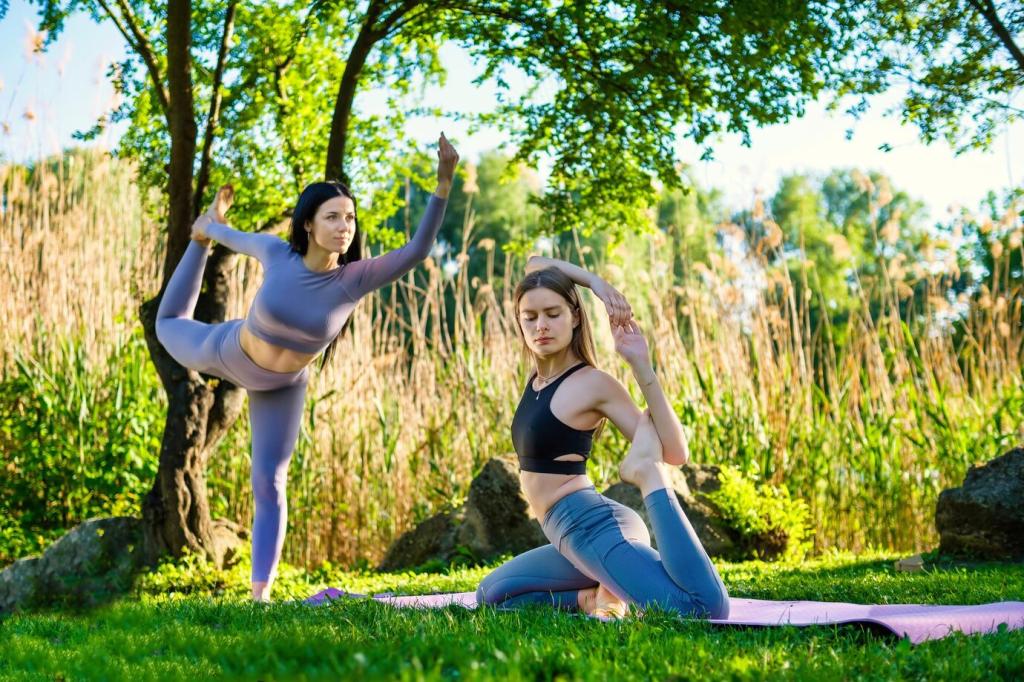Benefits of Seasonal Meditation in Mountain Settings
Chosen theme: Benefits of Seasonal Meditation in Mountain Settings. Welcome to a calm, wind-brushed starting point for your practice. From thawing streams in spring to crystalline winter air, each season in the mountains offers a distinct doorway into presence. Breathe with us, learn practical approaches, and share your own seasonal rituals as we explore how the high country strengthens attention, resilience, and joy.
Why Mountains Amplify Mindfulness Through the Seasons
Altitude, Oxygen, and the Breath
Thinner air encourages slower, deeper breathing, which can heighten interoceptive awareness and calm the nervous system. In spring, cool breezes support long exhales; in winter, crisp air invites shorter, mindful cycles. Respect your limits, pause often, and let the mountain set your pace. Tell us how altitude shapes your breath, and consider subscribing for seasonal breathwork tips.
Silence, Soundscapes, and Seasonal Cues
Spring birdsong layers delicate rhythms for focused listening, summer thunder reminds us to respect impermanence, autumn leaves whisper like beads, and winter snow hushes everything to stillness. Rotating through these natural cues prevents boredom and habituation. Try a five-minute sound-focused sit on your next visit, then share which seasonal sound most reliably anchors your attention.
Color Palettes and Cognitive Reset
Greens of spring renew optimism, brilliant summer skies energize, amber autumn tones invite release, and winter’s whites clarify priorities. Research suggests natural color variety can restore directed attention and spark awe. Create a color diary after each mountain session and notice patterns in mood. Comment with your favorite seasonal colors and how they shift your mindset.
Season-by-Season Benefits
Emerging trails, rushing rivulets, and first blossoms invite curiosity and gentle commitment. Spring is ideal for rebuilding consistency, pairing short sits with exploratory walks. Set small goals, like five mindful breaths at every switchback. Celebrate micro-wins to cement routine. Tell us your spring intention, and join others crafting a 30‑day renewal plan among budding pines and melting snow.
Long daylight windows support sunrise or sunset meditations, often with balmy temperatures and expansive views. Use abundant light for alertness and gratitude practices, while respecting heat exposure. Choose shaded groves, hydrate, and aim for compassion exercises after challenging ascents. Share your favorite dawn ridge, and subscribe for a printable early-morning checklist tailored for warm, high-elevation conditions.
Autumn teaches release through falling leaves; pair exhalations with what you’re ready to shed. Winter, quieter and slower, strengthens resilience and clarity as snow absorbs distractions. Dress in breathable layers, keep sessions shorter, and savor post-practice tea. Notice how cold sharpens focus without strain. Tell us one habit you’ll release in autumn and one quality you’ll cultivate in winter.
Evidence and Physiology Behind the Benefits
Stress, HRV, and Inflammation
Meditation can elevate heart rate variability, signaling parasympathetic balance, while time in natural environments correlates with reduced cortisol. Gentle cold exposure in winter may modestly affect inflammatory markers if practiced safely. Combine slow nasal breathing with short, frequent sessions. Share your observations on recovery after mountain practices, and we’ll send research summaries in our monthly science roundup.
Attention Restoration and Awe
Fractal patterns of ridgelines, shifting clouds, and flowing water invite soft fascination that replenishes directed attention. Seasonal novelty prevents sensory fatigue, keeping curiosity alive. Moments of awe can reduce self-focus and increase prosocial feelings. Capture one awe moment each season in a journal. Post your favorite entry, and inspire someone planning their first mountain meditation.
Sleep and Circadian Rhythm
Morning mountain light helps anchor circadian rhythm, supporting deeper sleep and steadier energy. Evening sessions at golden hour can unwind stress, but avoid bright headlamps afterward. In winter, aim for midday sun; in summer, catch first light. Track sleep for two weeks while practicing seasonally and report back—your insights may guide a community sleep challenge.
Practical Planning for a Mountain Meditation Year
In spring, pick lower, south-facing paths that thaw earlier. Summer favors shaded forests, higher lakes, or breezy ridges. Autumn calls for wind-sheltered overlooks away from hunters, while winter rewards sunny, compacted tracks. Scout backup spots and note quiet pockets. Comment with your region, and we’ll suggest seasonal site traits to consider for safer, steadier practice.

After a stressful winter indoors, Maya returned to a familiar creek where snowmelt sang beneath ice. She matched breath to the trickle, five counts in, five out. The ritual felt like removing a heavy coat. Her takeaway: start again, gently, and let small sounds lead. What spring sound helps you reset when discipline feels fragile?
Stories From the High Path

Spring Sensing Walk
Walk slowly for ten minutes and cycle through senses: five things you see, four you hear, three you feel, two you smell, one you taste. Pause by water if possible. This gradual layering wakes attention without strain. Comment with one detail you noticed that surprised you, and tag a friend to try the same route.

Summer Shade Sit With Loving-Kindness
Find a patch of shade, set a gentle timer, and direct kind phrases toward yourself, a friend, a neutral person, and a difficult person. Stay hydrated and keep posture cool and relaxed. Finish by naming three joys from the landscape. Share your phrases, and subscribe for printable cards you can bring on hot days.

Autumn Leaf Release or Winter Pebble Warmth
In autumn, hold a leaf, inhale the lesson it carries, then exhale and let it fall. In winter, warm two small pebbles in your pocket and count ten breaths while feeling their heat fade. Both practices teach non-grasping kindly. Post which version you tried and one feeling it helped you meet with gentleness.
Share Your Season Plan
Choose one mountain spot per season and commit to three short sessions there. Comment with your locations and intentions so others nearby can cheer you on. We’ll feature a few plans each month and report back on what worked best when weather, time, or motivation shifted unexpectedly.
Subscribe for Trail-Friendly Guides
Get quarterly, season-specific practice guides, safety checklists, and science notes designed for mountain settings. We keep emails lightweight and field-tested. Subscribe today, and reply with topics you want covered—family hikes, mindful trail running, or dawn routines—so we tailor our next edition to your real, seasonal needs.
Tell Us Your Favorite Mountain Sound
Is it spring melt, summer wind, autumn leaves, or winter silence? Describe one moment when that sound shifted your inner weather. Your story might inspire someone’s next sit. Add a photo if you have one, and invite a friend who needs a seasonal reset in the high country this week.
